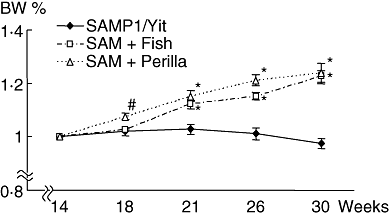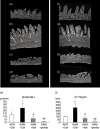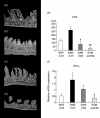Omega-3 polyunsaturated fatty acids ameliorate the severity of ileitis in the senescence accelerated mice (SAM)P1/Yit mice model
- PMID: 19793338
- PMCID: PMC2792829
- DOI: 10.1111/j.1365-2249.2009.04020.x
Omega-3 polyunsaturated fatty acids ameliorate the severity of ileitis in the senescence accelerated mice (SAM)P1/Yit mice model
Abstract
Clinical studies using omega-3 polyunsaturated fatty acids (omega3-PUFA) to Crohn's disease (CD) are conflicting. Beneficial effects of dietary omega3-PUFA intake in various experimental inflammatory bowel disease (IBD) models have been reported. However, animal models of large intestinal inflammation have been used in all previous studies, and the effect of omega3 fat in an animal model of small intestinal inflammation has not been reported. We hypothesized that the effects of omega3 fat are different between large and small intestine. The aim of this study was to determine whether the direct effect of omega3 fat is beneficial for small intestinal inflammation. Senescence accelerated mice (SAM)P1/Yit mice showed remarkable inflammation of the terminal ileum spontaneously. The numbers of F4/80-positive monocyte-macrophage cells as well as beta7-integrin-positive lymphocytes in the intestinal mucosa were increased significantly compared with those in the control mice (AKR-J mice). The area of mucosal addressin cell adhesion molecule-1 (MAdCAM-1)-positive vessels was also increased. The degree of expression levels of monocyte chemoattractant protein-1 (MCP-1), interleukin (IL)-6 and interferon (IFN)-gamma mRNA were increased significantly compared with those in the control mice. The feeding of two different kinds of omega3 fat (fish-oil-rich and perilla-oil-rich diets) for 16 weeks to SAMP1/Yit mice ameliorated inflammation of the terminal ileum significantly. In both the omega3-fat-rich diet groups, enhanced infiltration of F4/80-positive monocytes/macrophages in intestinal mucosa of SAMP1/Yit mice cells and the increased levels of MCP-1, IL-6 and IFN-gamma mRNA expression were ameliorated significantly compared with those in the control diet group. The results suggest that omega3 fat is beneficial for small intestinal inflammation by inhibition of monocyte recruitment to inflamed intestinal mucosa.
Figures





Similar articles
-
In vivo demonstration of T lymphocyte migration and amelioration of ileitis in intestinal mucosa of SAMP1/Yit mice by the inhibition of MAdCAM-1.Clin Exp Immunol. 2005 Apr;140(1):22-31. doi: 10.1111/j.1365-2249.2005.02742.x. Clin Exp Immunol. 2005. PMID: 15762871 Free PMC article.
-
Blockade of PSGL-1 attenuates CD14+ monocytic cell recruitment in intestinal mucosa and ameliorates ileitis in SAMP1/Yit mice.J Leukoc Biol. 2005 Mar;77(3):287-95. doi: 10.1189/jlb.0204104. Epub 2004 Nov 29. J Leukoc Biol. 2005. PMID: 15569697
-
Effect of dietary fat on intestinal inflammatory diseases.J Gastroenterol Hepatol. 2013 Dec;28 Suppl 4:33-6. doi: 10.1111/jgh.12252. J Gastroenterol Hepatol. 2013. PMID: 24251701 Review.
-
Lemon grass (Cymbopogon citratus) ameliorates murine spontaneous ileitis by decreasing lymphocyte recruitment to the inflamed intestine.Microcirculation. 2010 Jul;17(5):321-32. doi: 10.1111/j.1549-8719.2010.00032.x. Microcirculation. 2010. PMID: 20618690
-
Pathogenesis of gastritis in ileitis-prone SAMP1/Yit mice.Keio J Med. 2011;60(2):65-8. doi: 10.2302/kjm.60.65. Keio J Med. 2011. PMID: 21720202 Review.
Cited by
-
The Role of Lipids in the Regulation of Immune Responses.Nutrients. 2023 Sep 7;15(18):3899. doi: 10.3390/nu15183899. Nutrients. 2023. PMID: 37764683 Free PMC article. Review.
-
Beneficial effect of an omega-6 PUFA-rich diet in non-steroidal anti-inflammatory drug-induced mucosal damage in the murine small intestine.World J Gastroenterol. 2015 Jan 7;21(1):177-86. doi: 10.3748/wjg.v21.i1.177. World J Gastroenterol. 2015. PMID: 25574090 Free PMC article.
-
Effectiveness of omega-3 fatty acid administration on completion rate of adjuvant chemotherapy for biliary tract cancer: study protocol for a single-centre, open-label, single-arm, historically controlled study.BMJ Open. 2019 Aug 10;9(8):e029915. doi: 10.1136/bmjopen-2019-029915. BMJ Open. 2019. PMID: 31401605 Free PMC article.
-
Garlic Peel-Derived Phytochemicals Using GC-MS: Antioxidant, Anti-Inflammatory, and Anti-Apoptotic Effects in Ulcerative Colitis Rat Model.Pharmaceuticals (Basel). 2025 Jun 27;18(7):969. doi: 10.3390/ph18070969. Pharmaceuticals (Basel). 2025. PMID: 40732258 Free PMC article.
-
Anti-inflammatory effect of Perilla frutescens seed oil rich in omega-3 fatty acid on dextran sodium sulfate-induced colitis in mice.Res Pharm Sci. 2021 Aug 19;16(5):464-473. doi: 10.4103/1735-5362.323913. eCollection 2021 Oct. Res Pharm Sci. 2021. PMID: 34522194 Free PMC article.
References
-
- Podolsky DK. Inflammatory bowel disease. N Engl J Med. 2002;347:417–29. - PubMed
-
- Podolsky DK. Inflammatory bowel disease (1) N Engl J Med. 1991;325:928–37. - PubMed
-
- Satsangi J, Welsh KI, Bunce M, et al. Contribution of genes of the major histocompatibility complex to susceptibility and disease phenotype in inflammatory bowel disease. Lancet. 1996;347:1212–7. - PubMed
-
- Ogura Y, Bonen DK, Inohara N, et al. A frameshift mutation in NOD2 associated with susceptibility to Crohn's disease. Nature. 2001;411:603–6. - PubMed
-
- Hugot JP, Chamaillard M, Zouali H, et al. Association of NOD2 leucine-rich repeat variants with susceptibility to Crohn's disease. Nature. 2001;411:599–603. - PubMed
MeSH terms
Substances
LinkOut - more resources
Full Text Sources
Research Materials
Miscellaneous

